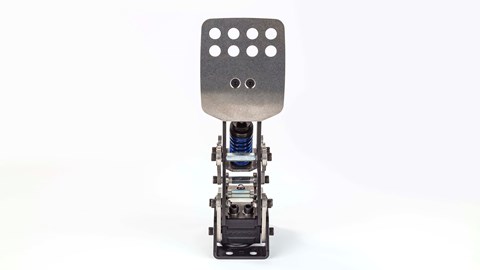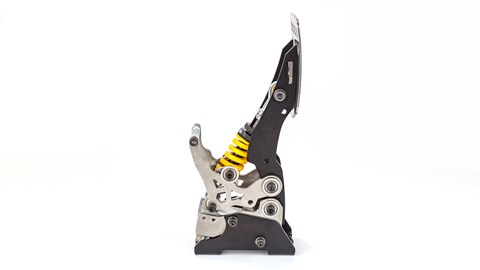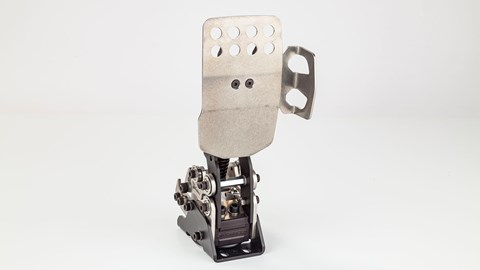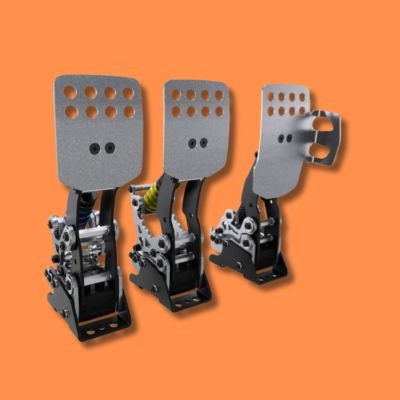► Professional-standard sim-racing pedals reviewed
► Innovative design and lots of adjustability
► Circa £470 purchase price
The Simgrade VX-Pro pedal set aims to deliver a super high-quality sim racing experience for both newcomers and pros alike, focusing on build quality, value-for-money and, most importantly, pedal feel. Unlike other manufacturers, Simgrade haven’t just focused on the brake, they’ve sought out strong performance across the board to help users with their speed and consistency.
Established in 2017, Simgrade is fairly new to the sim racing industry but the VX-Pro pedals mark its third pedal set since launch, following the R7 and Thera variants. All products are designed, manufactured and assembled in Finland with shipping across the world. At around £470 (plus any local taxes and delivery) the VX-Pro pedals are more expensive than, for example, Fanatec V3 Clubsports (approx £340), but significantly cheaper than high-end alternatives from Heusinkveld (approx £585) or Sim Lab (approx £555).
Should you swerve the big names and spend your money on the Simgrade VX-Pro for the ultimate sim-racing experience? Keep reading to find out.
Build quality
There’s an incredible sense of quality as soon as you begin unboxing the VX-Pros. They’re packaged tightly and professionally with indents and cut-outs in the cardboard tailor-made for the pedals – always a good sign.

Once bolted to your rig (largely straightforward with the correct tools), the unusual design is what immediately stands out. All three pedals stand in a much more upright position than is usual, almost to the point where you question how they will work.
However, Simgrade explain that the upright design is mostly down to the desire to create progressivity and feel in the pedals. Of course, the added benefit is that – with certain rig setups – the VX-Pros can save space thanks to a smaller footprint.
We’ll go into how the above translates into outright feel in the next section, but it’s also important to note how tightly put together everything is. There’s not a single creak or millimetre of unwanted movement anywhere in the set, plus the operation is near-silent thanks to the innovative way in which bearings roll on the load cell to deliver a signal.
Using this method also means that the leverage ratio changes as the spring moves further away from the main pivot point, thus giving a much more progressive feel to the pedal. Of course, there’s countless adjustment opportunities on offer (pedal angle, stiffness, pedal face), but the basic design lends itself to a more intuitive set-up. Note, too, that the pedals only use a single spring to deliver the resistance and stiffness in the pedals – there’s no additional elastomers in order to ensure consistency.
All of the above means that the VX-Pro pedals look and feel incredibly high quality even before you start to use them in the simulator. There’s also a two-year manufacturer warranty and, interestingly, Simgrade claim that they shouldn’t need any maintenance thanks to the load cell design and sealed bearings.
What are they like to use?
I’ll start with the throttle pedal. Right out of the pit lane it’s an incredibly precise and satisfying thing to use. The weighting/resistance (all adjustable) was just right for me and the feeling of the stopper at the end of the travel is beautifully judged. That said, if you prefer a more metal-on-metal feel, the stopper can be removed and gains a little more pedal travel in the process. The throttle pedal itself also uses a load cell, so it’s easier to gain muscle memory when it comes to squeezing on the power out of corners.
The clutch, too, feels satisfying to use and far from the afterthought it can be on other pedal sets. There’s also two different profile plates – one linear and one designed to mimic the biting point of a clutch – a neat addition. Note that, unlike on other pedal sets, the clutch does not have a hard stop point, so don’t go looking for this when calibrating.

Finally, the brake pedal. It’s absolutely exceptional – and I really do not say this lightly. Of course, you can delve into the adjustability options and I would encourage you to do so, but right out of the box the brake pedal is utterly superb, bursting with feel and an utter joy to use. If it doesn’t gain you time or consistency or – more likely – both, I would be very surprised.
I suspect some of this is down to the printed circuit board designed by part-time sim-racing content creator (and full-time electrical engineer) Dan Suzuki and the high EMI resistance that’s inherent within the VX-Pro pedals as a whole.
It’s clear from the calibration software and third-party telemetry apps that the electromagnetic interference barely registers in the signal from the pedals and this is absolutely crucial to delivering consistent performance. It’s no good if you’re on the limit of grip and a sudden ’jump’ in brake pressure causes you to lock up.
Another worthwhile feature is the two-stage brake pedal. This means that you can apply firm pressure on the brakes and feel a resistance point that stops you from going any further. Then, with a further squeeze, you can go beyond this resistance point and apply more brake pressure if needed. It’s super-useful for non-ABS cars or threshold braking and gives you a great reference point for when you’re sending it late down the inside. You can change this resistance point, but it’s not the work of a moment so not something you will want to do regularly between cars.

Finally, there’s a couple of options worth considering. The side support (around £20) sits on the outside of the throttle pedal (or any other pedal) and stops your foot sliding off, while the tilting heel support (around £50) gives an additional place to rest your foot on either the brake or accelerator. I’d recommend the former, but the improvement offered by the latter is more subjective depending on user. A brake kit is also available for around £34 but I haven’t tried this.
Any downsides?
Having tested the VX-Pro pedals in a number of different scenarios it really is hard to fault them for the price you’re paying. However – and Simgrade aren’t alone in this respect – I would like to see more clarity and depth in the instruction manual as well as associated guides to go along with the pedals.
The level of adjustability on offer is huge and while some will instinctively know what to change and what difference it will make, others may need inspiration. Not getting enough rotation on corner entry? Try a firmer brake pedal setting. Struggling with smooth throttle application? Change the travel settings. There’s plenty to delve into.
Price and competition
As mentioned, the £470 price tag compares very favourably to pedals of a similar quality. It’s less than you would pay for Sim-Lab XP1s and Heusinkveld Sprints, and around the same as Moza Racing CRPs.
Verdict
Pound-for-pound, the Simgrade VX-Pros are the best sim-racing pedals we’ve tested and without doubt one of the best on the market. For a little more than many entry-level rivals, the VX-Pros deliver professional-standard build quality, design, features and – most importantly – feel.
You may not have heard of Simgrade, but their engineering excellence and eye for detail has been put to the best possible use with the VX-Pros and I for one cannot wait to see what they do next.

Verdict score: 5/5
Pros:
• Brilliant build quality
• Plenty of adjustability
• Incredible brake pedal feel
Cons:
• Instructions could be better
More products to consider:
Fanatec ClubSport Pedals v3, RRP £389.90
HEUSINKVELD Sim Pedals Sprint 3-Pedal Set, RRP £581.31
Simlab Pedal Set XP1 Loadcell. RRP £555
Who tested it?
James Dennison is the Head of Automotive Video for CAR, but when he’s not in front of camera he’s a keen racer and sim racer. Having raced (virtually) since he was four years old, he’s seen his fair share of sim racing products over the years and is rated in the top 1% of drivers globally on the popular sim platform, iRacing.
How this product was tested
We tested this product on the iRacing sim racing platform using a variety of cars, tracks and conditions. We used the product with a Next Level Racing GT track rig and Fanatec CSL DD wheel base.
Just so you know, whilst we may receive a commission or other compensation from the links on this website, we never allow this to influence product selections – read why you should trust us